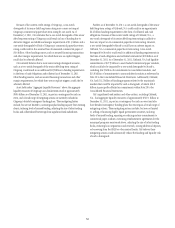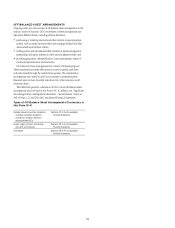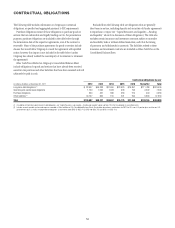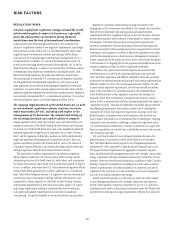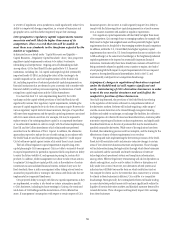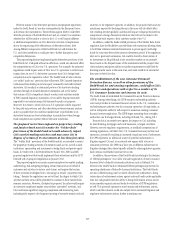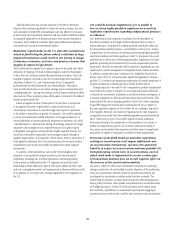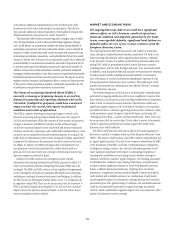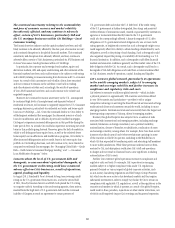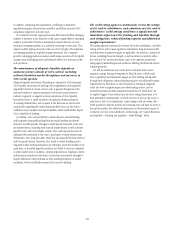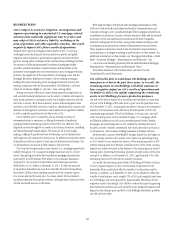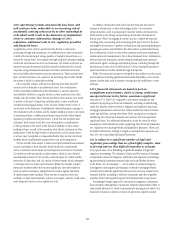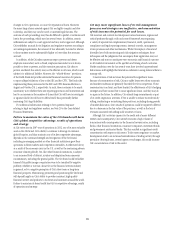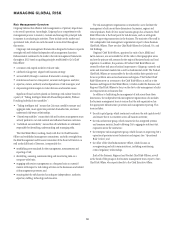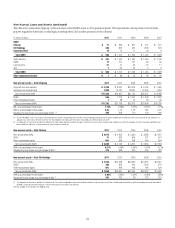Citibank 2011 Annual Report Download - page 84
Download and view the complete annual report
Please find page 84 of the 2011 Citibank annual report below. You can navigate through the pages in the report by either clicking on the pages listed below, or by using the keyword search tool below to find specific information within the annual report.62
BUSINESS RISKS
Citi is subject to extensive litigation, investigations and
inquiries pertaining to a myriad of U.S. mortgage-related
activities that could take significant time to resolve and
may subject Citi to extensive liability, including in the
form of penalties and other equitable remedies, that could
negatively impact Citi’s future results of operations.
Virtually every aspect of mortgage-related activity in the U.S. is being
challenged across the financial services industry in private and public
litigation and by regulators, governmental agencies and state attorneys
general, among others. Examples of the activities being challenged include
the accuracy of offering documents for residential mortgage-backed
securities, potential breaches of representations and warranties in the
placement of mortgage loans into securitization trusts, mortgage servicing
practices, the legitimacy of the securitization of mortgage loans and the
Mortgage Electronic Registration System’s role in tracking mortgages,
holding title and participating in the mortgage foreclosure process, fair
lending, compliance with the Servicemembers Civil Relief Act, and False
Claim Act violations alleged in “qui tam” cases, among others.
Sorting out which of the many claims being asserted has legal merit as
well as which financial institutions may be subject to liability with respect to
their actual practices is a complex process that is highly uncertain and will
take time to resolve. All of these inquiries, actions and investigations have
resulted in, and will likely continue to result in, significant time, expense and
diversion of management’s attention, and could result in significant liability
as well as negative reputational and other costs to Citi.
Citi is currently party to numerous actions relating to claims of
misrepresentations or omissions in offering documents of residential
mortgage-backed securities sponsored or serviced by Citi affiliates. This
litigation has been brought by a number of institutional investors, including
the Federal Housing Finance Agency. The cases are all in early stages,
making it difficult to predict how they will develop, and Citi believes that
such litigation will continue for several years. In addition, because the statute
of limitations will soon expire for these types of disclosure-based claims, Citi
could experience an increase in filed claims in the near term.
Citi is exposed to representation and warranty (i.e., mortgage repurchase)
liability through its U.S. Consumer mortgage businesses and, to a lesser
extent, through legacy private-label residential mortgage securitizations
sponsored by its S&B business. With respect to its Consumer businesses,
during 2011, Citi increased its repurchase reserve from approximately
$969 million to $1.2 billion at December 31, 2011. To date, the majority
of repurchase demands have come from the GSEs. The level of repurchase
demands by GSEs has been trending upwards and Citi currently expects
it to remain elevated for some time. To a lesser extent, Citi has received
repurchase demands from private investors, although these claims have been
volatile and could increase in the future.
With regard to legacy S&B private-label mortgage securitizations, while
S&B has to date received actual claims for breaches of representations and
warranties relating to only a small percentage of the mortgages included in its
securitization transactions, the pace of claims remains volatile and has recently
increased, Citi has also experienced an increase in the level of inquiries,
assertions and requests for loan files, among other matters, relating to such
securitization transactions from trustees of securitization trusts and others.
These inquiries could lead to actual claims for breaches of representations
and warranties, or to litigation relating to such breaches or other matters. For
additional information on these matters, see “Managing Global Risk—Credit
Risk—Consumer Mortgage—Representations and Warranties” and
“—Securities and Banking-Sponsored Private-Label Residential Mortgage
Securitizations—Representations and Warranties” below.
For further discussion of the matters above, see Note 29 to the
Consolidated Financial Statements.
Citi will not be able to wind down Citi Holdings at the
same pace as it has in the past three years. As a result, the
remaining assets in Citi Holdings will likely continue to
have a negative impact on Citi’s results of operations and
its ability to utilize the capital supporting the remaining
assets in Citi Holdings for more productive purposes.
Citi will not be able to dispose of or wind down the businesses or assets that
are part of Citi Holdings at the same level or pace as in the past three years.
As of December 31, 2011, assuming the transfer to Citicorp of the substantial
majority of retail partner cards, effective in the first quarter of 2012, LCL
constituted approximately 70% of Citi Holdings. As of such date, over half
of the remaining assets in LCL consisted of legacy U.S. mortgages which
will likely be subject to run-off over an extended period of time. Besides
mortgages, the remaining assets in LCL include the OneMain Financial
business, as well as student, commercial real estate and credit card loans in
North America, and consumer lending businesses in Europe and Asia.
BAM primarily consists of the MSSB JV. Morgan Stanley has call rights on
Citi’s ownership interest in the venture over a three-year period beginning
in 2012, which it is not required to exercise. Of the remaining assets in SAP,
interest-earning assets have become a smaller portion of the assets, causing
negative net interest revenues in the business as the remaining non-interest
earning assets, which require funding, represent a larger portion of the total
asset pool. In addition, as of December 31, 2011, approximately 25% of the
remaining assets in SAP were held-to-maturity securities.
As a result, the remaining assets within Citi Holdings will likely continue
to have a negative impact on Citi’s overall results of operations for the
foreseeable future, particularly after the transfer of retail partner cards to
Citicorp. In addition, as of December 31, 2011 and as adjusted to reflect the
transfer of retail partner cards, roughly 21% of Citi’s risk-weighted assets were
in Citi Holdings, and were supported by approximately $24 billion of Citi’s
regulatory capital. Accordingly, Citi’s ability to release the capital supporting
these businesses and thus use such capital for more productive purposes will
depend on the ultimate pace and level of Citi Holdings divestitures, portfolio
run-offs and asset sales.


